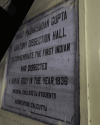A Trailblazer in Anatomy: Madhusudan Gupta and the Historic First Dissection
- PMID: 39483588
- PMCID: PMC11526181
- DOI: 10.7759/cureus.70612
A Trailblazer in Anatomy: Madhusudan Gupta and the Historic First Dissection
Abstract
The life and accomplishments of Madhusudan Gupta, a significant person in Indian medical history, are discussed in this review article. Born into an aristocratic Bengali family, Gupta initially showed little interest in formal education. However, his enrolment in Sanskrit College and subsequent involvement with Calcutta Medical College (CMC) marked a turning point in his life. Under European guidance, Gupta challenged deep-rooted societal and religious taboos by conducting the first cadaveric dissection in India, a groundbreaking act that significantly advanced anatomical studies in the country. Facing severe opposition, Gupta utilized his profound knowledge of Sanskrit texts to justify the practice of dissection, helping integrate Western medical practices into Indian education. His work not only revolutionized medical education in India but also paved the way for future reforms in the field. Gupta's legacy is honoured through various accolades, including the Pandit Madhusudan Gupta Memorial Lifetime Achievement Award, underscoring his crucial role in the development of modern anatomy and medicine in India.
Keywords: cadaver dissection; health professionals education; india; medical edu; professional ethics; social and cultural anthropology.
Copyright © 2024, G et al.
Conflict of interest statement
Conflicts of interest: In compliance with the ICMJE uniform disclosure form, all authors declare the following: Payment/services info: All authors have declared that no financial support was received from any organization for the submitted work. Financial relationships: All authors have declared that they have no financial relationships at present or within the previous three years with any organizations that might have an interest in the submitted work. Other relationships: All authors have declared that there are no other relationships or activities that could appear to have influenced the submitted work.
Figures


References
-
- Books, bones and bodies: the relevance of the history of anatomy in Nazi Germany for medical education today. Hildebrandt S. Anat Rec (Hoboken) 2022;305:886–901. - PubMed
-
- Re-examining our roots: queer history and anatomy. Smith TC. Anat Rec (Hoboken) 2022;305:968–982. - PubMed
-
- The Flemish anatomist Andreas Vesalius (1514-1564) and the kidney. DeBroe ME, Sacré D, Snelders ED, De Weerdt DL. Am J Nephrol. 1997;17:252–260. - PubMed
-
- Sella turcica: an anatomical, endocrinological, and historical perspective. Tekiner H, Acer N, Kelestimur F. Pituitary. 2015;18:575–578. - PubMed
Publication types
LinkOut - more resources
Full Text Sources
